Address
304 North Cardinal St.
Dorchester Center, MA 02124
Work Hours
Monday to Friday: 7AM - 7PM
Weekend: 10AM - 5PM
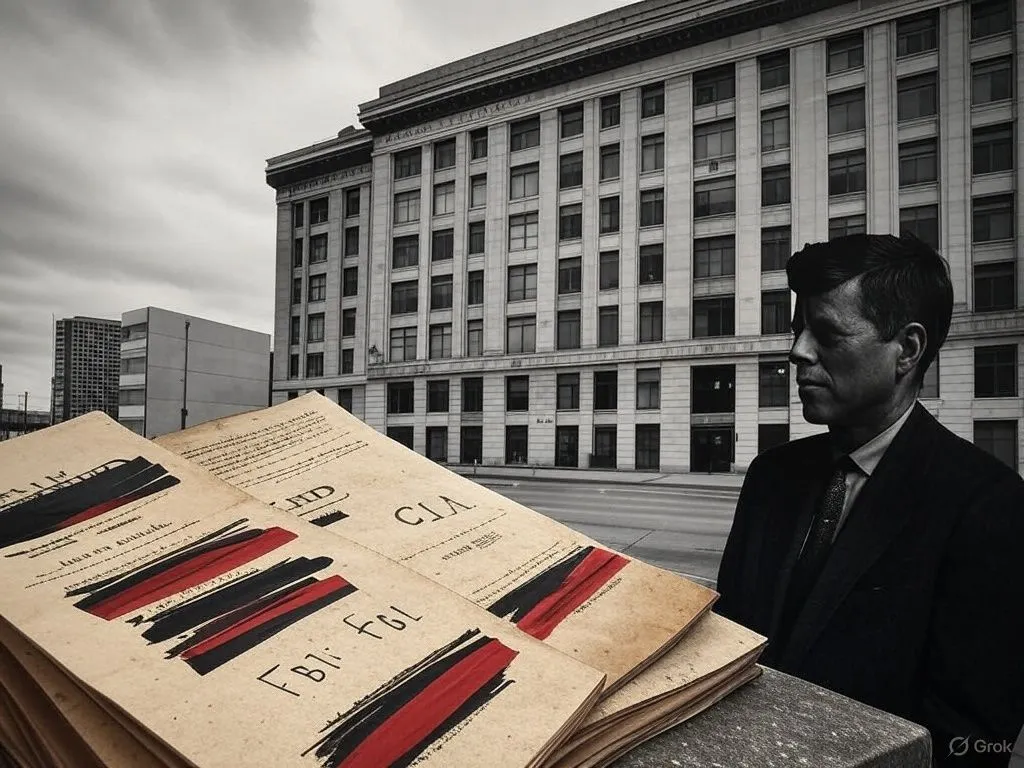
The assassination of President John F. Kennedy on November 22, 1963, remains one of the most scrutinized events in modern history. Officially attributed to Lee Harvey Oswald, the case has been clouded by decades of speculation, conspiracy theories, and conflicting narratives. The U.S. government has periodically released classified documents related to the assassination, but large portions have remained redacted or withheld due to national security concerns. Now, with former President Donald Trump announcing the imminent release of 80,000 pages of previously classified JFK assassination files, the question arises: Will this be a moment of historic transparency, or yet another exercise in controlled disclosure?
The National Archives and Records Administration (NARA) has been responsible for the gradual release of JFK-related files since the passage of the 1992 JFK Assassination Records Collection Act, which mandated full declassification by 2017 unless a sitting president delayed the release for national security reasons. Trump’s administration allowed for partial disclosure in 2017 and 2018, but thousands of pages remained withheld at the request of the intelligence community. The Biden administration followed suit, keeping select records classified even as pressure mounted for full transparency.
With this latest release, intelligence professionals and historians will closely examine whether these files provide meaningful new insights or simply repackage existing information. The key areas of interest include Oswald’s connections to intelligence agencies, foreign government involvement, discrepancies in official reports, and potential security lapses that contributed to JFK’s death. Additionally, the release may shed light on Cold War-era covert operations, revealing new details about U.S. intelligence activities in Cuba, the Soviet Union, and Latin America.
However, historical precedent suggests that truly sensitive revelations—particularly those that could implicate government agencies or expose classified sources and methods—may still be withheld or heavily redacted. Intelligence agencies have a well-documented history of protecting institutional interests, even in cases of declassification. This raises an essential analytical question: What is likely to be revealed, and what will remain buried?
This report applies an intelligence analysis framework to assess what can realistically be expected from the upcoming JFK file release. By examining declassification trends, intelligence methodologies, and historical context, we will evaluate the probabilities of different types of revelations and their implications. Whether this is a moment of unprecedented disclosure or yet another half-truth remains to be seen, but through structured analysis, we can begin to separate fact from myth.
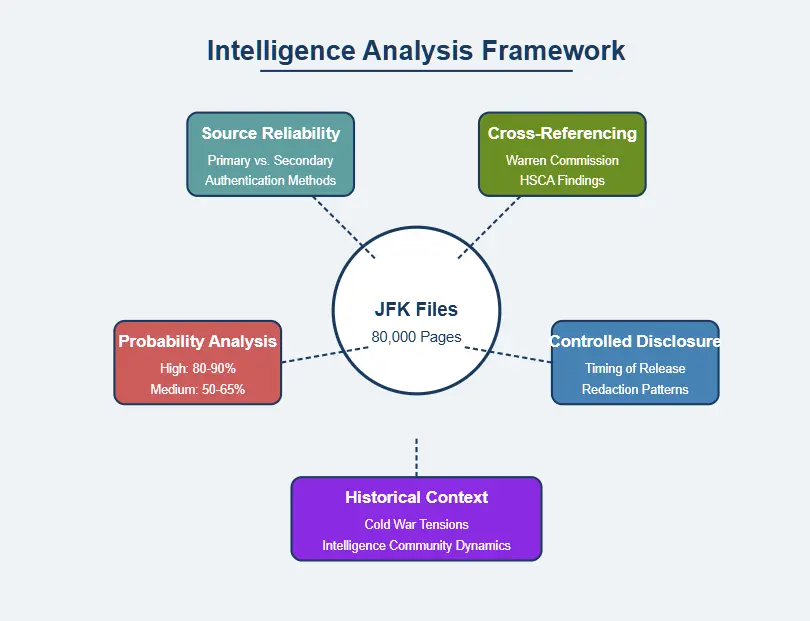
Analyzing the declassification of government intelligence documents requires a structured methodology. Intelligence professionals do not take newly released documents at face value; instead, they assess the information in relation to historical context, prior disclosures, and known gaps in the record. Given the U.S. government’s history of selective declassification—where less sensitive information is often released to divert attention from more damning material—it is crucial to approach this release with a critical, forensic lens.
The primary challenge in assessing the JFK files is distinguishing genuinely new information from previously released material that has been mildly altered or strategically declassified. The following intelligence methodologies provide a structured approach to extracting meaningful insights from the newly available records:
Not all documents carry equal weight. Intelligence professionals categorize information based on its origin, corroboration, and susceptibility to manipulation. Key considerations include:
Past declassifications of JFK-related files have shown a pattern of key details being withheld or manipulated. For example, in previous releases, some CIA records appeared to downplay Oswald’s presence in Mexico City despite intelligence indicating he was in contact with both Cuban and Soviet officials. Analysts will need to determine whether this release provides unredacted details or continues the pattern of controlled disclosure.
A single declassified document is rarely sufficient to establish a new historical truth. Analysts must compare these files against existing archives, including:
This cross-referencing process is vital for identifying discrepancies and inconsistencies. For example, if a newly released memo suggests that Oswald had no known connections to intelligence agencies, but previous records indicate he was monitored closely before the assassination, analysts would need to determine why such contradictions exist.
To assess the significance of the newly released documents, we categorize potential findings into probability tiers based on past intelligence leaks, historical patterns of declassification, and political considerations. The probability matrix is as follows:
High Probability (80%–90%)
Medium Probability (50%–65%)
Low Probability (25%–30%)
This probability assessment is based on historical precedent. The U.S. government has consistently withheld the most sensitive intelligence details from declassification efforts, even decades after the events in question. As such, it is more likely that this release will contain bureaucratic memos and low-to-mid-level intelligence assessments rather than a definitive “smoking gun.”
Intelligence agencies frequently use selective declassification as a means of narrative control. If damaging information is included in this document release, it will likely be buried within thousands of pages of mundane or repetitive material. To understand how controlled disclosure works, analysts will consider:
Given these factors, intelligence analysts must be wary of prematurely declaring this release a victory for transparency. The real test will be in the level of detail provided, the consistency of the new information with prior disclosures, and whether any fundamental historical narratives are challenged by these documents.
While the upcoming JFK file release may provide new insights into the assassination and the intelligence failures surrounding it, analysts must remain skeptical of the extent to which this declassification represents true transparency. By applying structured intelligence methodologies—assessing source reliability, cross-referencing existing records, and identifying patterns of controlled disclosure—researchers can separate genuine revelations from strategic misdirection.
The next sections will apply these analytical frameworks to assess what specific types of information are most likely to emerge from the newly declassified pages and what impact they may have on historical and geopolitical narratives.
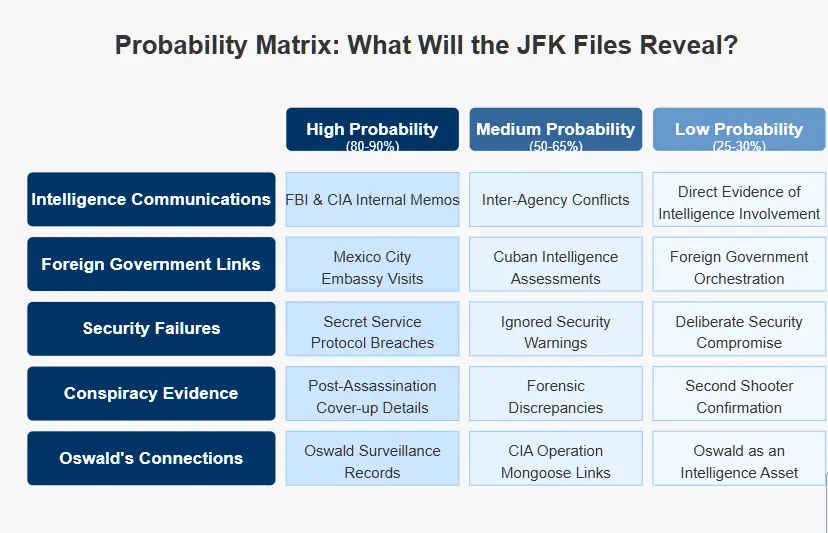
While there is no expectation of a definitive “smoking gun” in this document release, there are several high-probability areas where new details may emerge. Based on past declassification trends and the nature of intelligence disclosures, analysts can expect the following key areas to be addressed with a high degree of certainty.

One of the most anticipated aspects of this release is additional insight into how the U.S. intelligence community tracked Oswald prior to and after the assassination.
A crucial focus will be whether these documents contain references to Oswald’s ties—formal or informal—to any intelligence agency. Historically, some researchers have argued that Oswald may have been an asset or under surveillance, which could significantly shift interpretations of the assassination if confirmed.
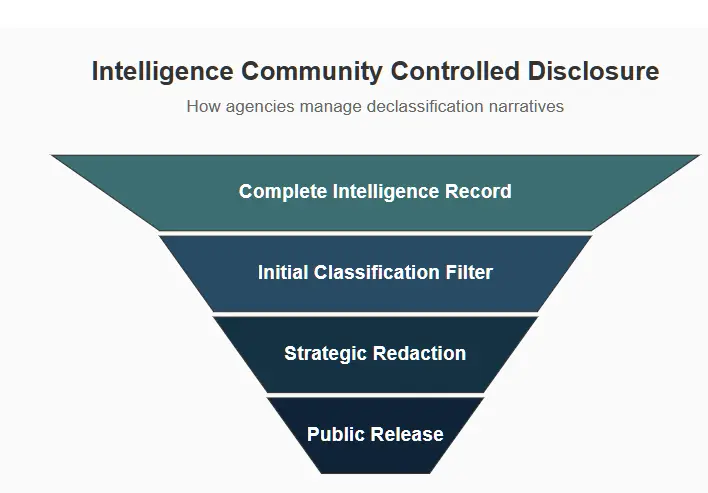
Oswald’s interactions with foreign embassies in Mexico City—particularly the Soviet and Cuban embassies—have long been a point of speculation. High-probability findings in this area include:
These details could provide a clearer picture of whether Oswald had any external encouragement or if his foreign interactions were merely coincidental. However, it is unlikely that the files will directly implicate a foreign government in orchestrating JFK’s assassination.
The role of the U.S. Secret Service on November 22, 1963, has been a subject of extensive debate. The agency’s failure to protect President Kennedy effectively remains one of the most scrutinized aspects of the assassination. Expected revelations include:
The likelihood of these details emerging is high because they do not necessarily compromise ongoing national security concerns. However, significant redactions may still obscure key portions of these records.
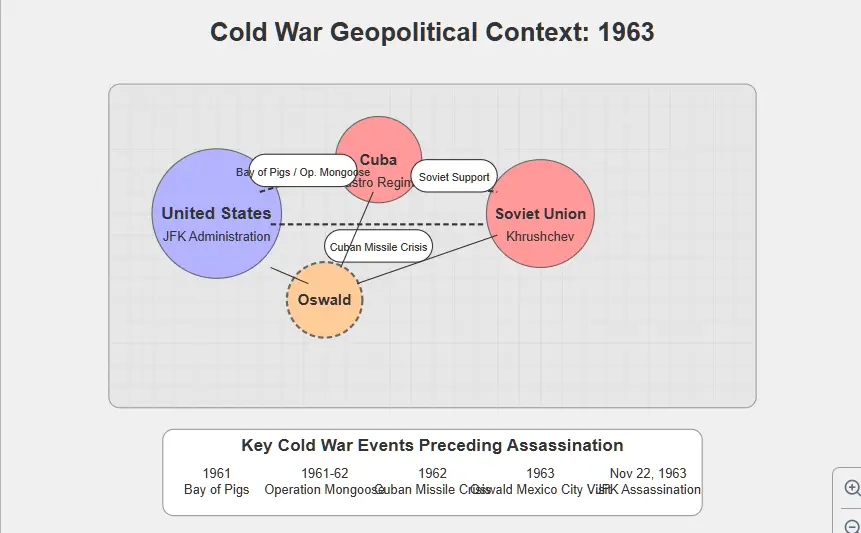
One of the lesser-discussed but crucial aspects of the JFK assassination is the inter-agency rivalry between the FBI and CIA. Intelligence failures often stem not only from a lack of information but also from institutional conflicts that prevent effective action. Expected disclosures include:
These documents could provide new insights into the bureaucratic failures that may have allowed Oswald to carry out the assassination unchecked.
Given historical patterns of intelligence declassification, the most probable new revelations from this release will involve inter-agency communications, post-assassination analysis, and additional foreign intelligence assessments. While these may add new layers of detail, they are unlikely to completely upend the mainstream historical narrative.
The following questions will be key in analyzing the significance of the JFK file release:
While full transparency remains unlikely, these files will nonetheless provide new pieces of the puzzle—potentially confirming past suspicions, revealing intelligence blunders, and reigniting debates about one of the most consequential events in American history.
While the most likely revelations from the JFK files involve intelligence bureaucracy, surveillance records, and security failures, there are several key areas where new information might emerge. These fall into the category of medium probability (50-65%)—details that could be declassified but may still be partially redacted due to ongoing national security concerns or institutional interests.
This section focuses on three main areas: CIA covert operations, forensic inconsistencies, and the enduring debate over whether Oswald was truly a lone actor.
A significant portion of the JFK assassination context revolves around CIA activities during the Cold War. Kennedy’s foreign policy, particularly his handling of Cuba and the Soviet Union, put him at odds with elements within the intelligence community. The files may include:
While there is little expectation of a direct link between CIA covert ops and JFK’s assassination, newly revealed intelligence on Cuba-related operations could provide missing context about the broader geopolitical tensions of the time.
One of the most enduring debates surrounding JFK’s assassination is whether a second shooter was involved. The files could provide additional information related to:
It remains unlikely that these files will directly confirm or disprove the existence of a second shooter. However, minor forensic details or contradictions in previous reports could emerge, adding new complexities to the case.
Another area of potential new revelations is intelligence oversight and communication breakdowns. The files may contain:
These intelligence failures are among the most likely revelations because they do not necessarily compromise national security today. However, the government may still redact key names and operational details.
If these files confirm any of the above, they could significantly reshape aspects of the JFK narrative:
While these revelations wouldn’t necessarily prove a grand conspiracy, they would add new layers of complexity to an already murky historical event.
The next section will cover low-probability revelations—the most sensational possibilities, such as direct evidence of conspiracy, the unredacted identities of key intelligence operatives, and whether Oswald was more than just a lone gunman.
While most of the JFK files are expected to provide bureaucratic insights, intelligence failures, and previously redacted foreign government assessments, some of the more sensational theories surrounding the assassination may still be addressed in this release. However, these revelations fall into the low probability (25-30%) range, as they either conflict with longstanding government narratives or could still be withheld under national security exemptions.
This section explores the most unlikely but still possible disclosures: direct proof of a conspiracy, confirmation of additional shooters, and new identifications of key intelligence operatives who may have been involved in or aware of events leading up to JFK’s assassination.
The release of 80,000 pages of classified documents raises the possibility—however slim—that some files will directly contradict the Warren Commission’s lone gunman conclusion. While previous declassifications have revealed intelligence failures and foreign government concerns, a full admission of conspiracy would be unprecedented.
Possible revelations that could indicate a conspiracy include:
The probability of these documents emerging is low—if such evidence ever existed, it is likely to have been destroyed or permanently withheld. However, smaller contradictions or inconsistencies in declassified records could still raise serious questions about the official account.
One of the most significant barriers to fully understanding the JFK assassination has been the extensive redactions in previously released files. While most of these redactions were to protect intelligence sources and methods, some could be concealing the names of individuals whose involvement in the case has been long speculated.
Possible low-probability revelations in this category include:
Again, while the probability of such direct evidence emerging is low, intelligence releases have been known to contain unexpected disclosures when reviewed in full.
The theory that more than one shooter was involved in the assassination is one of the most widely debated elements of the JFK case. Officially, the Warren Commission (1964) and House Select Committee on Assassinations (1979) concluded that Oswald acted alone, but the latter acknowledged that there was a “probable conspiracy” due to acoustic evidence suggesting multiple gunmen.
If the files contain any acknowledgment of additional shooters, it could appear in several ways:
The probability of explicit proof of multiple shooters being released is very low, but forensic inconsistencies may still emerge in newly declassified documents.
While the full declassification of JFK files is a historic event, it remains unlikely that the most explosive revelations—such as confirmation of a conspiracy or direct proof of multiple shooters—will emerge. However, intelligence analysts and historians should still closely examine:
Even if outright conspiracy confirmation is absent, previously classified details could still add new complexities to the historical record, raising more questions than they answer.
The release of 80,000 pages of declassified JFK assassination files is not just an exercise in transparency; it carries significant implications for intelligence agencies, the media, and public perception. While many expect a historic disclosure, the reality is that the intelligence community is adept at shaping narratives even through controlled releases.
This section examines how the files will likely be framed, potential geopolitical consequences, and whether the release will clarify or further muddy the historical record.
Government document releases, particularly those tied to historic events, are rarely left to public interpretation. The intelligence community actively manages expectations, often through selective disclosures and strategic media narratives.
The key takeaway: Intelligence agencies are experts at controlling narratives even when releasing documents. The framing of this release will likely downplay any new revelations while reinforcing existing conclusions.
Controlled disclosure refers to the practice of releasing information selectively to maintain a preferred narrative while withholding truly damaging details. The JFK files will likely follow this pattern, meaning that:
The key takeaway: While the JFK files will provide some interesting new details, they are unlikely to contain the full truth. Intelligence agencies are highly skilled at shaping disclosure to control public perception.
One of the major potential revelations in these files is further documentation on Oswald’s interactions with foreign governments, particularly Cuba and the Soviet Union. If new evidence emerges linking Cuban intelligence (DGI) or Soviet operatives (KGB) to Oswald, it could:
The key takeaway: If the release contains new foreign intelligence assessments, it could reshape Cold War historiography and influence modern discussions on government transparency.
For over six decades, the JFK assassination has been a battleground of competing narratives. While the U.S. government has maintained that Oswald acted alone, public skepticism has remained high, largely due to intelligence secrecy and past contradictions.
The upcoming release could go one of two ways:
Given the U.S. government’s historical approach to the JFK files, a full resolution of the case remains highly unlikely. Instead, this release is more likely to generate additional questions rather than provide definitive answers.
The key takeaway: This document release may not bring closure but will likely reignite public interest in the case, reinforcing both official and alternative narratives.
The release of 80,000 pages of JFK assassination files is a major historical moment, but it is unlikely to fully resolve the case. The intelligence fallout will be shaped by:
Even with this release, the JFK assassination is unlikely to be definitively solved. However, intelligence professionals, historians, and researchers will have a new trove of documents to analyze, and potential gaps in past narratives may become clearer.
The declassification of 80,000 pages of JFK assassination files is a major historical event, but whether it delivers genuine transparency or merely reinforces existing uncertainties remains to be seen. The assassination of President John F. Kennedy has remained one of the most debated topics in modern history, and this latest document release will likely continue that tradition rather than resolve it.
Despite six decades of government investigations, intelligence reports, and independent research, public skepticism about the official narrative remains high. The Warren Commission’s conclusion that Lee Harvey Oswald acted alone has been challenged by alternative theories suggesting intelligence agency involvement, organized crime connections, and even foreign government influence. The critical question is: Will this release bring clarity, or will it further obscure the truth?
Based on intelligence declassification trends, this release is expected to follow a familiar pattern of partial disclosure:
In short, this release will likely add new details to the historical record but will not fundamentally alter the official conclusion that Oswald was the sole assassin.
Even if no major new revelations emerge from this release, the debate over JFK’s assassination will not end. Instead, the files may introduce new contradictions, inconsistencies, or overlooked details that fuel further research.
Moving forward, intelligence analysts, historians, and independent researchers will focus on:
If significant redactions remain or critical documents are missing, it will only reinforce suspicions that key aspects of the case are still being withheld.
Regardless of what these files reveal, the JFK assassination will likely remain an open question for decades to come. The event has become more than just a historical mystery—it is a symbol of government secrecy, intelligence failures, and deep mistrust in official narratives.
If the files contain no new evidence of a conspiracy, it will not convince those who already believe that the truth is still hidden. If the files contain contradictions or omissions, it will only fuel more speculation.
Ultimately, the release of these documents is not the end of the JFK story—it is just the next chapter. For intelligence analysts, researchers, and historians, the real work begins after the documents are released, as they piece together what has been disclosed, what remains missing, and what it all means for understanding one of the most pivotal moments in modern history.